Using Ad Tracking Data to Improve Programmatic Campaigns in 2025
In the fast-changing world of programmatic media, businesses don’t have to guess how their campaigns are doing anymore. They can use ad tracking data as a clear tool to see exactly how programmatic ads work and connect with people. Think of it like a helpful guide leading you through the world of automated ad buying, showing what gets clicks, conversions, and real results. That’s what ad tracking brings to programmatic campaigns—a way to improve strategies and reach customers better.
Ad tracking here means gathering and reviewing data about how people interact with programmatic ads—those bought and shown through automated, real-time bidding systems. It’s a big part of today’s programmatic media, giving you info on impressions, clicks, conversions, and even detailed things like how people engage. But it’s not just numbers on a screen; it’s about figuring out the people behind those numbers and making smart choices with that info. In this blog, we’ll look at what ad tracking data does for programmatic campaigns, why it’s so important, and how it leads to success. We’ll also show how GeoSpot Media uses ad tracking to help brands stand out in this busy space.
What Is Ad Tracking Data in Programmatic Campaigns?
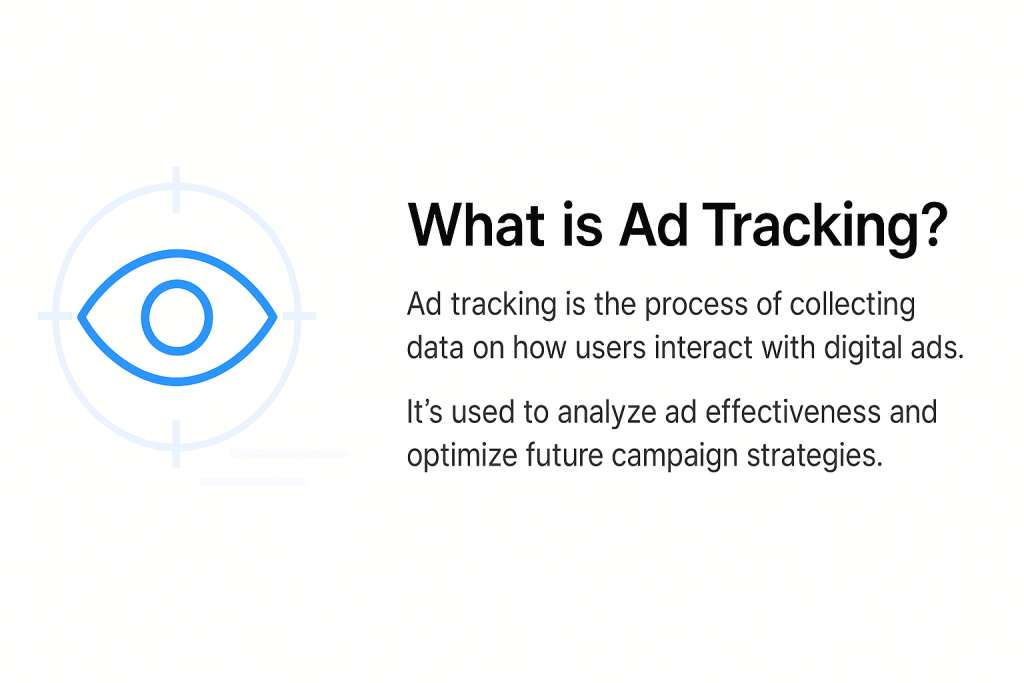
Ad tracking data is the information you collect about how people react to programmatic ads—ads placed through automated systems like demand-side platforms (DSPs) and ad exchanges. It covers things like how many times an ad was shown (impressions), how many clicks it got, and if it led to an action, like a purchase or sign-up. It’s a full picture of an ad’s path from when it’s bought to when it affects someone’s choice.
For businesses using programmatic media, this data changes everything. It gives you a clear view of how your campaign is performing right now. Without ad tracking, you might think your ad is doing well based on a gut feeling. With it, you know for sure if it’s working or falling short. Programmatic ad spending is growing fast—set to make up over 90% of display ad budgets by 2025, according to a 2024 eMarketer report. With that much at stake, guessing isn’t good enough. Ad tracking makes sure every programmatic campaign is based on solid facts, helping you make better decisions.
The Human Side of Ad Tracking: Beyond Just Numbers
Data might feel cold, but every number in ad tracking comes from a person’s action. A click isn’t just a figure—it’s someone deciding to check out your brand. Ad tracking in programmatic campaigns helps you see these human stories on a big scale, showing what drives your audience and how they act. For example, if your data shows more clicks from mobile users between 8 p.m. and 10 p.m., it might mean people—like workers relaxing after a long day or late-night browsers—are engaging with your ads then. You could use that to schedule your ads for those hours or adjust them to match what those users need, making sure your message reaches them when they’re ready.
This link to real people is why ad tracking is so key in programmatic media. It’s not just about improving results; it’s about making ads that matter to your audience. When you know what catches their eye, you can create programmatic ads that feel personal and important—something that’s huge when people see tons of ads every day.
Take Sarah, a small business owner selling eco-friendly home goods. She starts a programmatic campaign but gets modest results. Looking at her ad tracking data, she sees her ads do best with mobile users in city areas. She puts more money into targeting those groups and changes her ad images to focus on sustainability, which they care about. Soon, her conversions go up a lot. That’s ad tracking in action: turning data into choices that connect with people.
How Ad Tracking Data Helps You Make Better Decisions
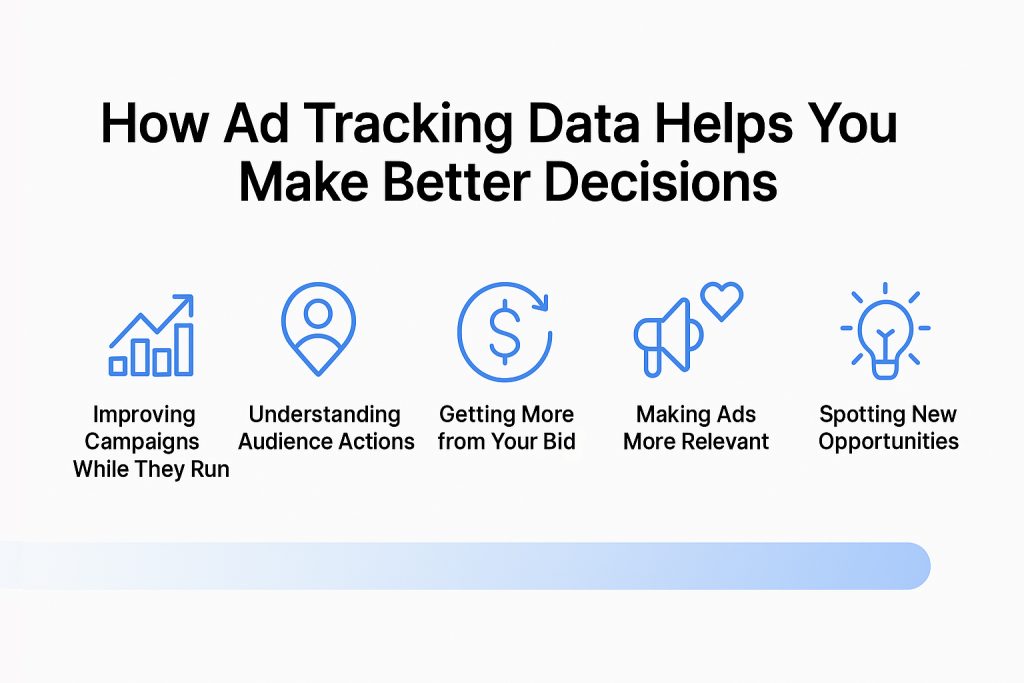
It gives you the info you need to improve your campaigns and get better results. Here’s how it works, with more detail and examples:
1. Improving Campaigns While They Run
Ad tracking shows you how your programmatic ads are performing right as they happen. You get quick updates on things like whether people are clicking your ads or if your cost per sale (how much you pay for each conversion) is staying within your budget. Metrics like click-through rates (CTR)—the percentage of people who click after seeing your ad—and impressions (how many times your ad is shown) help you spot what’s working or not.
- Example: Imagine you’re running a programmatic campaign for a fitness app. Ad tracking shows your banner ads have a low CTR of 0.5%, but your video ads hit 2%. You could tweak the campaign by pausing the banners and putting more budget into videos. Or maybe the data shows clicks drop on weekends—you could lower bids then and save money for weekdays when people are more active. This way, you adjust on the fly and get the best results.
2. Understanding Audience Actions
Ad tracking tells you who’s clicking your programmatic ads, where they’re from, and how they act. It digs into details like location (cities or regions), device types (mobile or desktop), and behavior (like when they’re most active). This helps you see patterns and make your ads fit your audience better.
- Example: Suppose you sell outdoor gear and notice through ad tracking that clicks are high in coastal towns but low inland. You could bid more to show ads in those coastal areas and tweak your message—like highlighting beach camping gear—to match what those people might want. Or if mobile clicks outpace desktop, you could focus your budget on mobile-friendly ad designs. It’s about knowing your audience and meeting them where they are.
3. Getting More from Your Budget
Programmatic budgets have limits, and ad tracking helps you spend smarter. It shows which ad placements (like specific websites or apps) or audience groups (like age ranges or interests) bring the best results—like more sales or sign-ups. This lets you put your money where it works hardest instead of spreading it too thin.
- Example: Let’s say you’re advertising a new coffee brand. Ad tracking reveals that ads on food blogs give you a $5 return for every $1 spent, while ads on news sites barely break even. You could shift your budget to those food blogs and cut back on news sites. Or if 25–34-year-olds convert twice as much as other ages, you’d focus your bids there. It’s about making every dollar count.
4. Making Ads More Relevant
People respond better to ads that feel made for them—81% are more likely to act on personal experiences, according to a 2023 Accenture study. Ad tracking helps you divide your audience into groups and target them with ads that match their interests, right when they’re paying attention.
- Example: If you run a pet store, ad tracking might show that past buyers of dog food click retargeted ads more than new visitors. You could set up a programmatic campaign to show those buyers ads for dog treats, while new users see a general “welcome” ad. Or if data shows evening clicks are high, you’d schedule ads then—maybe with a “relax with your pet” vibe. This keeps your ads useful and engaging.
5. Spotting New Opportunities
Ad tracking isn’t just about what’s happening now—it can hint at what’s next. When you see a sudden rise in clicks or interest around something, it might mean a trend is starting. This lets you change your programmatic plan to jump on those opportunities before others do.
Example: Picture a clothing brand running ads for sweaters and jeans. Ad tracking shows a big spike in clicks on sweaters in early fall, but jeans stay flat. You could pivot your budget to push sweaters more—maybe adding a “cozy season” theme—while scaling back on jeans until later. It’s like catching a wave before it peaks, keeping you ahead of the game.
Tools That Power Ad Tracking in Programmatic Media

Ad tracking in programmatic campaigns relies on a set of tools that quietly collect and organize data behind the scenes. These tools are essential for understanding how your ads perform and making smart adjustments. Here’s a closer look at what they are and how they work:
1. Tracking Pixels
These are small pieces of code placed in ads or webpages, like landing pages, to track user actions—clicks, form fills, or purchases. They send this data to your Independent Trading Desk or demand-side platform (DSP), showing how people interact with your campaign. They’re essential for connecting ad views to results, helping you measure what works. Without them, you’d lack a clear link between spending and user behavior.
2. Independent Trading Desk or DSP Dashboards
These built-in tools in programmatic platforms act as your live control panel, displaying key stats like impressions, clicks, and engagement rates in one spot. They update in real time, so you can see campaign performance instantly. This helps you catch trends or issues—like low attention or rising costs—fast, making it easier to track progress and decide what needs changing on the go.
3. First-Party Data
This is info you collect directly from your audience, such as website visits, sign-ups, or customer actions. With third-party cookies fading due to privacy shifts, it’s a vital, reliable alternative from your own users. It builds a clear picture of preferences and habits, letting you target programmatic ads accurately and keep tracking strong as tech rules evolve.
4. Attribution Tools
These tools track the full journey to conversions—like sales or sign-ups—beyond just the last click. They map all touchpoints, from seeing an ad to acting later, using models like multi-touch or first-touch attribution. This shows which campaign parts drive value, giving a deeper understanding of ad placements and audience impact for better decision-making.
The tools you choose depend on your campaign’s size and goals. Small businesses might use standard features, while larger ones add advanced analytics or custom attribution. The focus is on accurate, easy-to-use data for confident action.
Challenges in Ad Tracking for Programmatic Campaigns
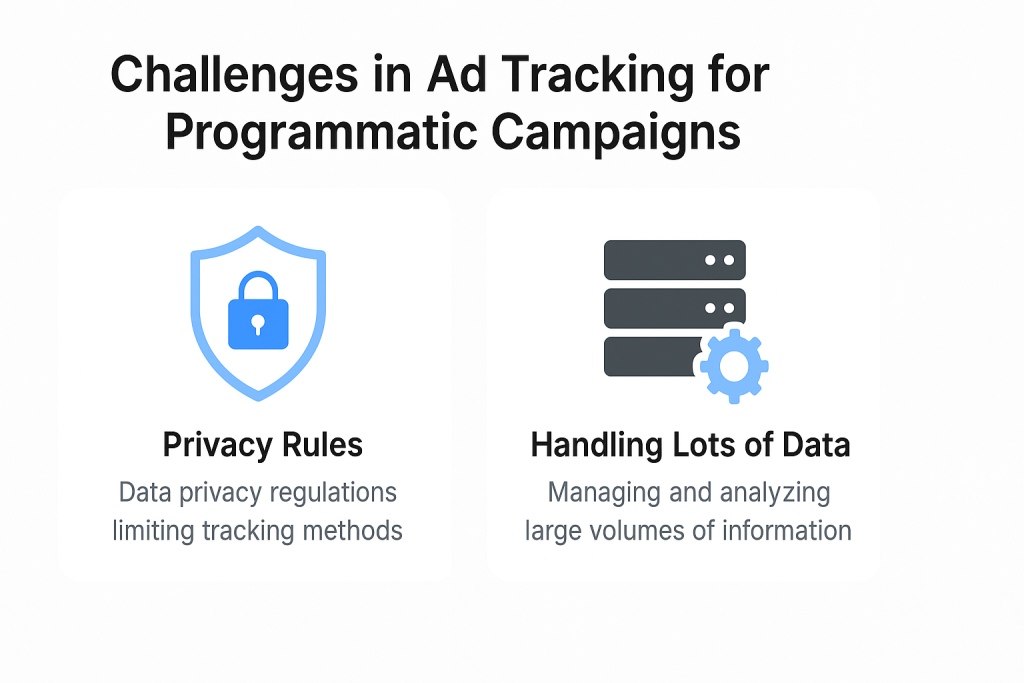
Ad tracking has big benefits, but it’s not always easy. Here are the main hurdles and how to handle them, with examples:
1. Privacy Rules
Laws like GDPR in Europe and CCPA in California, plus tech shifts like fewer cookies, mean you can’t track the old way anymore. You have to rethink how you gather data, using your own info or placing ads based on webpage content—not a user’s past—to stay legal and keep working well.
- Example: If you’re advertising skincare, you can’t rely on cookies to track someone’s past searches. Instead, use data from your own site—like what products people view—and target ads on beauty blogs, not personal histories. Or bid on pages about “dry skin tips” to reach the right crowd safely.
2. Handling Lots of Data
Programmatic campaigns produce a huge amount of info—impressions, clicks, costs, and more. It’s easy to feel swamped. The trick is to focus on numbers tied to your goals—like sales or sign-ups—not just everything, so you stay on track and make clear decisions.
- Example: Imagine you’re promoting a music app. Ad tracking shows 1 million impressions, 5,000 clicks, and 500 downloads. If your goal is downloads, you’d ignore the big impression number and focus on what boosts those 500—like tweaking ad text or targeting music fans more. It keeps you from drowning in extra details.
GeoSpot Media’s Take
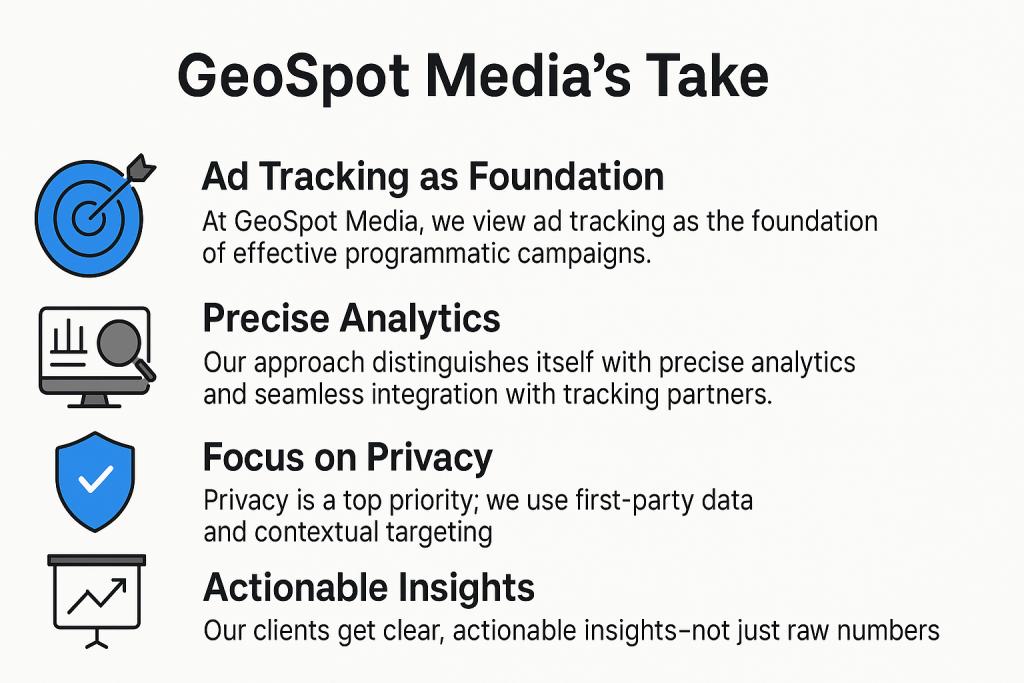
At GeoSpot Media, we view ad tracking as the foundation of effective programmatic campaigns. We specialize in premium programmatic media buying, and our strength lies in using ad tracking to deliver results. We combine smart technology with a focus on real people to help brands grow in a competitive landscape.
Our approach distinguishes itself with precise analytics and seamless integration with tracking partners. We leverage advanced tools like macros and event APIs to gather comprehensive data—such as device IDs, click events, and conversions—making every campaign fully measurable and optimized. Specifically, we support a range of macros, including [PLACEMENT_ID] for unique placement or app identification and [DEVICE_ID] capturing mobile device data, among others. These capabilities ensure granular insights into campaign performance. Privacy is a top priority; we use first-party data and contextual targeting to ensure effective and globally compliant tracking. Whether it’s display, mobile, or video ads, we monitor performance across all channels, providing a holistic view of your campaign’s impact.
Our clients get clear, actionable insights—not just raw numbers. We provide concise reports with tailored suggestions, turning data into practical steps for success. For example, a retail brand might see mobile ads in urban areas driving evening sales. We’d adjust bids to target that window and refine creatives for convenience, boosting conversions fast. With support for Open RTB formats and partnerships with top ad exchanges, our tracking capabilities power efficient, high-impact campaigns. At GeoSpot Media, ad tracking isn’t just a tool—it’s how we fuel programmatic wins and drive your growth.
Best Tips for Ad Tracking in Programmatic Campaigns
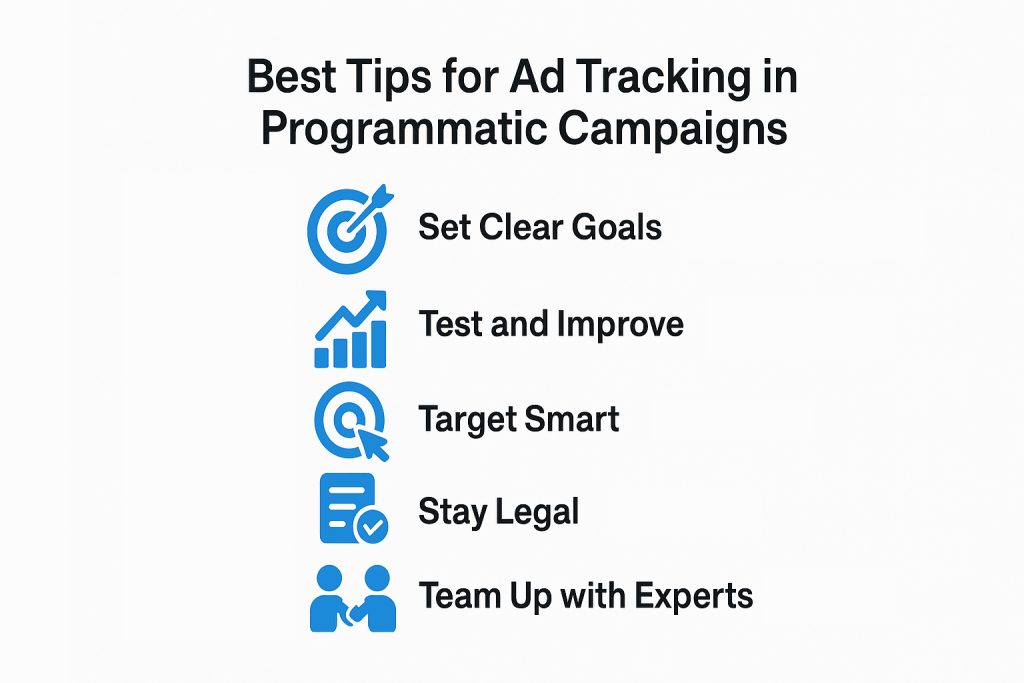
Ready to use ad tracking to improve your programmatic work? These steps will help you get started and make the most of your data. Here’s how to do it right:
1.Set Clear Goals: Decide what you want to achieve with your campaign, like boosting sales, increasing sign-ups, or growing engagement. Then, focus your tracking on those specific outcomes. For example, if sales are your aim, track conversions and cost-per-sale, not just impressions. Clear goals keep your data relevant and guide your decisions, ensuring you measure what matters most to your business.
2.Test and Improve: Experiment with different ad styles—like banners versus videos—or targeting options, such as age groups or locations. Use ad tracking to see which performs best, then put more effort into what works. If data shows one version doubles clicks, scale it up and drop the weaker ones. Testing lets you refine your campaign based on real results, not guesses.
3.Target Smart: Use the insights from ad tracking to reach the right people in your programmatic buys. Look at data like device types, times of day, or regions with high engagement, and adjust your targeting to match. If mobile users respond more, focus bids there. Smart targeting makes your ads hit the mark, connecting with audiences who care.
4.Stay Legal: Be upfront about how you collect data and stick to safe tracking methods that follow privacy laws like GDPR or CCPA. Use first-party data from your own site or opt-in forms, and avoid outdated tactics like third-party cookies. Staying legal builds trust and keeps your campaign running smoothly in a privacy-first world.
5.Team Up with Experts: Partner with professionals like GeoSpot Media to streamline your ad tracking and boost results. Experts bring tools, experience, and know-how—like integrating with tracking partners or analyzing complex data—so you avoid pitfalls and get actionable insights fast. Their support can turn good tracking into great outcomes for your campaign.
Conclusion
Ad Tracking as Your Path to Programmatic Success Ad tracking data turns the uncertainty of programmatic campaigns into clear, actionable insights. It helps you understand your audience, improve your ads, and make every budget dollar work harder in a fast-moving media world. From spotting trends to targeting the right people, it’s the key to staying ahead. Whether you’re a small business or a big brand, ad tracking lifts your results by showing what works and why. At GeoSpot Media, we make this process simple and effective. Our expertise transforms data into smart decisions—and those decisions into real growth. Ready to boost your programmatic campaigns with ad tracking? Connect with us today and let’s build your success together.




Post Comment